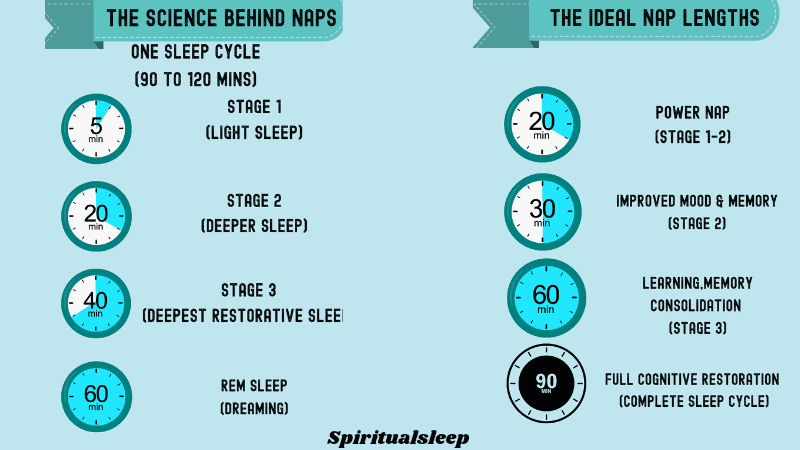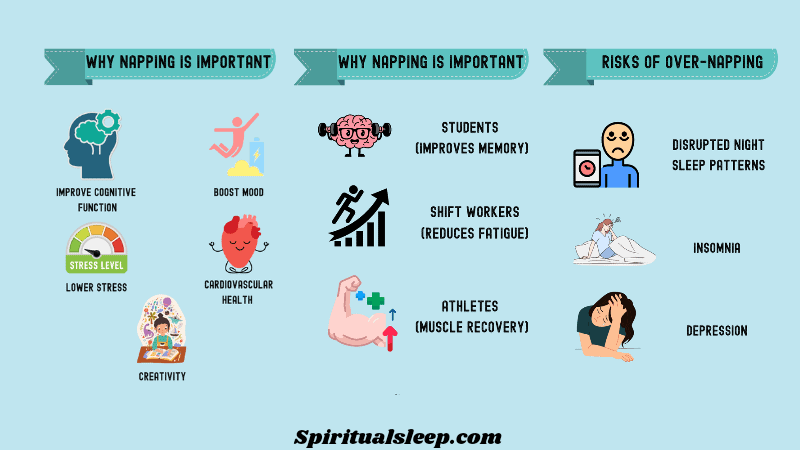How Long is a Good Nap? The Ideal Nap Length Guide
Table of Contents
Understanding the Power of Naps
You’re feeling sluggish in the afternoon, your focus is waning, and you think, “Maybe I should take a nap.” But how long should it be? Will a short nap even help, or will a long nap leave you groggy?
If you’ve ever woken up from a nap feeling worse than before, you’re not alone. Many struggle to find the right nap length to feel refreshed instead of disoriented. Napping too long can interfere with nighttime sleep, while a short nap might not provide enough rest.
As a medical doctor interested in sleep health, I often recommend strategic napping to my patients. The key is understanding the science behind different nap lengths. This guide will walk you through the ideal nap times for boosting energy, enhancing memory, and avoiding the pitfalls of oversleeping.
Why Napping is Important for Health and Productivity
Naps are not just for children or older people. Research shows that napping can:
- Improve cognitive function
- Boost mood
- Enhance creativity
- Lower stress levels
- Improve cardiovascular health
A NASA study found that pilots who took a 26-minute nap improved their performance by 34% and alertness by 54%. This is why even high-performing professionals incorporate naps into their schedules.
Furthermore, a systematic review published in Sleep Health revealed that individuals who nap regularly have a 37% lower risk of heart disease than those who rarely nap.

The Science Behind Naps: Sleep Cycles Explained
Sleep is divided into several stages:
- Stage 1 (Light Sleep): This lasts a few minutes, and you drift between sleep and wakefulness.
- Stage 2 (Deeper Sleep): Brain activity slows, and body temperature drops. This stage typically occurs within 10-20 minutes.
- Stages 3 and 4 (Slow-Wave Sleep) are deep, restorative sleep. Waking from these stages often causes grogginess.
- REM Sleep: The dreaming stage is essential for memory and emotional processing.
The length of your nap determines how far you progress into these stages. Short naps stay in light sleep, while longer naps can enter deeper stages.
The Ideal Nap Lengths: What Works Best?
10-20 Minute Nap (Power Nap)
Best for: Quick energy boost, improving alertness
Why it works: This nap keeps you in light sleep (Stage 1-2), preventing grogginess. It’s perfect for a midday recharge without affecting nighttime sleep. I often recommend this nap to patients working long shifts or needing quick focus restoration.
A study from Sleep Journal found that a 10-minute nap produced immediate improvements in cognitive performance and mood.
30-Minute Nap
Best for: Memory enhancement, slight mood improvement
Why it works: This nap may dip into Stage 2 sleep but avoids deep sleep. However, waking from this nap can lead to sleep inertia – that groggy feeling.
Pro Tip: I advise my patients to set a timer for 25 minutes to avoid the downsides of this nap length.
60-Minute Nap
Best for: Learning, memory consolidation
Why it works: This nap includes deep, slow-wave sleep (Stage 3). It enhances memory recall but increases the chance of grogginess upon waking.
Harvard Medical School research shows that a 60-minute nap improves memory and problem-solving skills.
90-Minute Nap (Full Sleep Cycle)
Best for: Full cognitive restoration, enhanced creativity
Why it works: This nap allows you to complete one sleep cycle, including REM sleep. It minimizes grogginess and maximizes benefits. I often recommend this nap to patients recovering from sleep deprivation.
Real-Life Example: I sometimes take a 90-minute nap after a long night on call. It leaves me refreshed and sharp for the next shift.
When is the Best Time to Nap?
The best time to nap is typically between 1 PM and 3 PM. This aligns with the body’s natural circadian rhythm, where energy dips in the afternoon.
Avoid Too Late: Napping after 4 PM can interfere with nighttime sleep. I advise my patients to nap earlier to avoid disrupting their natural sleep-wake cycle.

Napping for Specific Groups
Students and Learners
- Improves memory and retention
- Enhances creative problem-solving
- Boosts alertness for late-night study sessions
A study at the University of California showed that students who took 60-90 minute naps before exams performed better on memory-based tasks than those who stayed awake.
Shift Workers
- Reduces fatigue during long shifts
- Enhances focus and reduces errors
I often recommend naps during break periods to medical interns working night shifts. A 20-minute nap during a 12-hour shift can significantly reduce fatigue and improve patient care.
Athletes
- Boosts muscle recovery
- Enhances performance
- Reduces injury risk
A study in the Journal of Sports Sciences found that athletes who incorporated daily naps improved reaction times and endurance.
Common Mistakes to Avoid When Napping
- Napping Too Long: Napping beyond 30 minutes can push you into deep sleep, leading to grogginess and sleep inertia. If you need a quick refresh, stick to 10-20 minutes. Longer naps can be beneficial but should be timed strategically to allow a complete 90-minute sleep cycle.
- Napping Too Late in the Day: Napping after 4 PM can interfere with your ability to fall asleep at night. Aim to nap between 1 PM and 3 PM, when the body naturally experiences an energy dip. I advise my patients to align naps with this window to avoid nighttime sleep disruptions.
- Ignoring Sleep Environment: Attempting to nap in noisy, bright environments reduces nap efficiency. A quiet, calm, and dark space can improve the quality of your nap. I often recommend blackout curtains and noise machines to enhance relaxation.
- Not Setting an Alarm: It’s easy to oversleep during a nap. Setting an alarm helps you wake up at the optimal point in your sleep cycle, preventing you from feeling groggy.
- Lying Down for Too Long Before Sleeping: If you spend more than 10-15 minutes trying to fall asleep, get up and try again later. Forcing sleep can lead to frustration, making it harder to relax.
- Relying on Naps Instead of Nighttime Sleep: Naps are a supplement, not a replacement for proper nighttime rest. If you frequently feel the need for long naps, it may indicate sleep deprivation or other sleep disorders.
- Napping Without a Goal: Different nap lengths serve different purposes. If you need a quick energy boost, aim for a power nap (10-20 minutes). Consider a longer nap (60-90 minutes) for memory enhancement. Choose the duration that aligns with your goals.
- Napping Too Long: Leads to sleep inertia. Stick to 10-20 minutes if you need a quick refresh.
- Napping Too Late in the Day: Disrupts nighttime sleep.
- Ignoring Sleep Environment: A quiet, dark space improves nap quality.
I recommend using a sleep mask and earplugs to enhance nap quality, especially in bright or noisy environments.
How to Nap Like a Pro: Practical Tips
- Set the alarm: Prevent oversleeping by setting a timer for 20-30 minutes. This ensures you wake up before deep sleep kicks in, reducing the risk of grogginess. I often tell my patients to start with 20 minutes and adjust as needed based on how refreshed they feel.
- Nap Early: Aim for naps before 3 PM to avoid interfering with nighttime sleep. This aligns with the body’s natural dip in energy. Patients who follow this guideline report better nighttime sleep and increased afternoon productivity.
- Create a Nap-Friendly Space: A quiet, calm, dark space significantly enhances nap quality. Block out the light with blackout curtains or a sleep mask, and use earplugs or noise machines to mask disruptive sounds.
- Use White Noise: Calming background noise, such as ocean sounds or steady rain, can help you drift into sleep faster. I use a white noise app during short naps at the clinic between shifts, and it helps me disconnect quickly.
- Incorporate Relaxation Techniques: Before napping, engage in 2-3 minutes of deep breathing or meditation. This lowers your heart rate and prepares your body for rest.
- Choose a Comfortable Position: Lying down is best, but even reclining in a chair can work if you’re at work or travelling. Patients often report better nap quality when they invest in ergonomic recliners or travel pillows.
- Time Your Naps Strategically: If you know you’ll have a long evening or night ahead, plan a 90-minute nap earlier to reset your mental energy.
- Experiment and Track Results: Keep a nap journal to track how different nap lengths affect your energy and mood. This can help you fine-tune your nap habits for maximum benefit. Set a timer for 20-30 minutes to prevent oversleeping.
- Nap Early: Aim for naps before 3 PM.
- Create a Nap-Friendly Space: Quiet, calm, and dark spaces enhance rest.
- Use White Noise: Block out distractions with calming background noise.
The Risks of Over-Napping
While naps are beneficial, excessive daytime sleep can lead to:
- Insomnia
- Increased risk of depression
- Disrupted nighttime sleep patterns
If patients report frequent oversleeping during the day, I assess for underlying conditions like sleep apnea or depression.
Medical Disclaimer:
This article is based on thorough research, scientific studies, and my personal experience as a medical doctor interested in sleep health. This content is for informational purposes only and should not be considered medical advice. Each individual’s sleep needs and health conditions are unique. I recommend consulting with a healthcare professional or sleep specialist to address specific concerns for better sleep.
Conclusion
Napping is a powerful tool for boosting energy, improving mood, and enhancing cognitive function. The ideal nap length depends on your goals – whether you need a quick recharge or deeper restoration. By understanding the science of naps and tailoring their length, you can harness their full benefits without compromising nighttime sleep.
As a sleep-focused doctor, I encourage everyone to embrace napping as a healthy routine. Even minor adjustments to your nap length can significantly improve daily performance and overall well-being.
References
- Rosekind, M. R., et al. (1994). NASA Ames Fatigue Countermeasures Program.
- Brooks, A., & Lack, L. (2006). The effects of 10-minute naps on mood and performance. Sleep.
- Mednick, S. C., et al. (2003). The restorative nature of naps. Harvard Medical School.
- Yamada, T., et al. (2021). Meta-analysis on naps and heart health. Sleep Health.
- Walker, M. P., & Stickgold, R. (2010). Naps and memory consolidation. University of California.
- Samuels, C. (2008). Naps and athletic performance. Journal of Sports Sciences.



Улучши свои навыки танца живота нина и вина урок 1 с бонусами и ставками на спорт в 1win — лидере онлайн-казино! Получи до 1000 фриспинов, быстрый вывод выигрышей, высокие коэффициенты для лайв-ставок и шанс выиграть реальные деньги уже сегодня. Регистрация за минуту, минимальный депозит — доступность, которую ценишь!